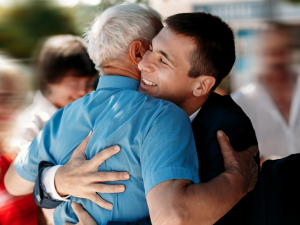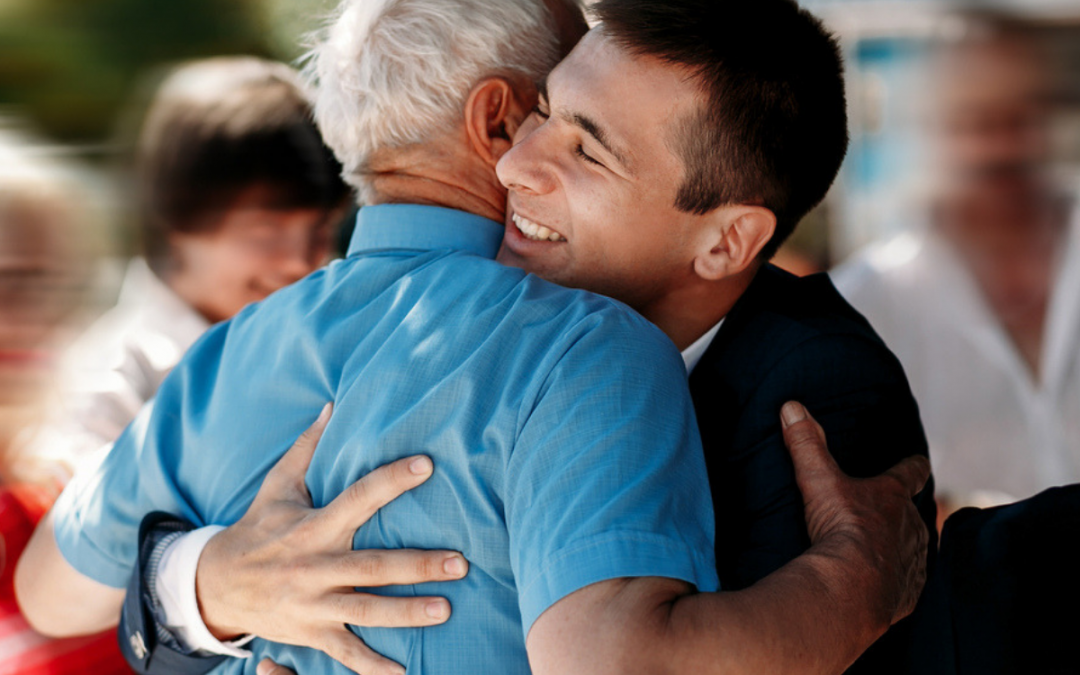By Ray Williams
July 20, 2020

Physical touch is a fundamental part of being a human. The current COVID-19 pandemic has put severe restrictions on touching, and it may have a long-term negative impact on our well-being.
Physical distancing and the lack of human touch has accompanied our response to preventing the spread of COVID-19. Platonic physical touch among friends and colleagues is off limits. Hugs, high-fives, friendly friendly pats on the back, shaking hands, kissing, and even sexual contact breaches the physical distancing “rules ” recommended or even mandated by health professionals. People used to regular physical contact have altered their physical contact behaviors, including that at family gatherings, weddings, funerals and outdoor activities and church services.
And it doesn’t end there. COVID-19 patients are often put in isolation, separated from loved ones and devoid of physical contact with health care workers because of the requirement for Personal Protective Equipment.
Positive human touch is an integral part of human interaction. Whether it’s a warm embrace, a reassuring hand on the shoulder or one arm linked through another, physical contact is a large part of how we show concern and establish camaraderie with friends and loved ones.
“Human beings are wired to touch and be touched. When a child is born, that is how they bond with their mother—through touch,” said Asim Shah, M.D., professor and executive vice chair of the Menninger Department of Psychiatry at Baylor College of Medicine. “Our wiring system has touch everywhere, so it’s difficult for us not to think about physical contact.”

Touch starvation
Two hundred years ago, a creature looking somewhat human, was sighted running through the forests of Southern France. Once captured, scientists determined he was age 11, and had run wild in the forests for much of his childhood. One of the fathers of psychiatry at that time, Phillipe Pinel, observed the child—named “Victor”—and concluded, erroneously, that the Victor was an idiot. A French physician attending Victor, disagreed with Pinel, concluding that the child had merely been deprived of human physical touch, which had retarded his social and developmental capacities.
Communist Romanian dictator Nicolae Ceausescu, in a pathological program to raise the birth rate through “science,” established numerous orphanages. When the world was able to see these orphans after his overthrow, they were shocked to see severe underdevelopment in their social skills and values. The commonality for all these orphans was a lack of human physical touch, particularly of the loving kind.

When physical contact becomes limited—or, in some cases, eliminated—people can develop a condition called touch starvation or touch deprivation.
“When someone is [touch] starved, it’s like someone who is starved for food,” Shah said. “They want to eat, but they can’t. Their psyche and their body want to touch someone, but they can’t do it because of the fear associated with, in this case, the pandemic.”
Touch starvation increases stress, depression and anxiety, triggering a cascade of negative physiological effects. The body releases the hormone cortisol as a response to stress, activating the body’s “flight-or-fight” response. This can increase heart rate, blood pressure, respiration and muscle tension, and can suppress the digestive system and immune system—increasing the risk of infection.
People who are stressed or depressed, perhaps because of lack of touch, will have problems sleeping, Shah said.“Every single medical disease including heart attack, diabetes, hypertension, asthma—every single physical disease—is altered if you are more anxious, more depressed or if you have more mental health issues,” he said,
Long term, he added, going an extended period without positive physical touch can even lead to post-traumatic stress disorder.
Physical Touch Through The Ages
Ever had cold feet at night? People had a remarkable solution to this problem in the Middle Ages. Many nobles in medieval Europe had large beds that allowed a noble, his wife, their children, some servants, and his knights to sleep together in the dead of winter. If this sleeping arrangement sounds a little too cozy, this is probably because modern people like you and I have come to regard the practice of sleeping together with one’s entire household as shameful and uncivilized. Indeed, over the centuries, various forms of interpersonal touch have become less and less common, squelched under an onslaught of changing cultural values and new technology.
Even before COVID-19, we have increasingly viewed touch as unhygienic and even invasive, as in the case of sexual harassment, for example. And sequestering ourselves behind phones and laptop screens has only exacerbated the trend.
Given that interpersonal touch is increasingly becoming a scarce commodity, it is important to ask how touch influences our lives. Why is touching and being touched by others so important to us? New research suggests that even fleeting forms of touch may have a powerful impact on our emotional and social functioning. For instance, people can communicate distinct emotions such as anger or sadness through touch. Moreover, people who are touched briefly on the arm or shoulder are more likely to comply with requests such as volunteering for charity activities.
These findings could have far-ranging implications for the role of touch in everyday life and point to important applications in therapy and virtual communication.
Physical contact distinguishes humans from other animals. From a warm handshake or sympathetic hug to a congratulatory pat on the back, we have developed complex languages, cultures, and emotional expression through physical contact. But in a tech-saturated world, non-sexual human touch is in danger of becoming rare, if not obsolete.
The Benefits of Physical Touch
Our skin is the largest organ in the human body, covering us from head to toe.
A 2018 study by scientists at the Medical College of Wisconsin in Milwaukee found that skin communicates positive and negative touch stimuli to our sensory neurons.
The outermost layer of our skin, called the epidermis, is predominantly made up of billions of keratinocyte cells. The keratinocytes release a chemical called adenosine triphosphate (ATP), which activates receptors on the sensory nerve to convey the sensation of touch to the brain.
When we hug or feel a friendly touch on our skin, our brains release oxytocin, a neuropeptide involved in increasing positive, feel-good sensations of trust, emotional bonding and social connection, while decreasing fear and anxiety responses in the brain at the same time. For this reason, oxytocin is affectionately known as the “cuddle hormone.”
Our desire for physical contact starts at birth. “If a baby is born prematurely, the baby may be in the NICU [neonatal intensive care unit], but the mother is still asked to go to the NICU a few times a day to hold the baby and put the baby on her chest, even if they’re not breastfeeding,” Shah explained. “We know that this bonding, this human-to-human touch, is important for the growth of that child.” Even as adults, touch helps regulate our digestion and sleep, and even boosts our immune systems.
We know from child developmental research that the absence of physical bonding and healthy attachment between an adult and child may result in life-long emotional disturbances. James W. Prescott, an American developmental psychologist, proposed that the origins of violence in society were related to the lack of mother-child bonding.
In the early 1950s, American psychologist Harry Harlow provided a dramatic demonstration of the importance of touch in coping. Harlow set out to study the effect that separation from their mothers has on children by conducting a range of controversial experiments with baby Rhesus monkeys. Harlow raised the baby monkeys in isolation in a cage that contained two surrogate “mothers” – one made of metal wire and the other wrapped in terrycloth.

Although the wire mother contained a bottle from which the monkeys could nurse, the monkeys would cling to the terrycloth mother when they were frightened, even when this led them to dehydrate and starve. Harlow’s monkeys were apparently hungry for something other than food: They were literally starving for a warm, comforting touch. With these studies, Harlow was the first to show that intimate body contact, and not feeding, was the most important factor in mother-child bonding.
Whether we get a friendly slap on the back, a sensual caress, or a loving kiss –interpersonal touch has a powerful impact on our emotions. In fact, our skin contains receptors that directly elicit emotional responses, through stimulation of erogenous zones or nerve endings that respond to pain. Furthermore, research by Matthew Hertenstein, director of the Touch and Emotion Lab at DePauw University, has shown that touch may communicate distinct emotions. Hertenstein and his associates asked pairs of participants to sit at a table with a curtain between them, so that they were unable to see one another.
One of the participants, the encoder, was asked to communicate distinct emotions (e.g. anger, disgust, fear, sympathy) by touching the other person’s arm. The person being touched, the decoder, was asked to identify the communicated emotion from a number of response options. Although they could neither see nor talk to each other, the participants were able to encode and decode distinct emotions such as anger, fear and disgust at above-chance levels.
The emotional impact of interpersonal touch is ingrained in our biology. Indeed, there is some direct evidence that, in mammalian species, touch triggers the release of oxytocin, a hormone that decreases stress-related responses. Researchers first tested this idea by stroking rats’ abdomens for 30-45 seconds. They found that this type of soft touch raised rats’ oxytocin levels.
Interpersonal touch can also induce oxytocin release among humans. For instance, in one experiment, couples who engaged in a warm touch exercise, during which they touched each other’s neck, shoulders, and hands, had more oxytocin in their saliva than couples who did not engage in this exercise. Likewise, women who report frequent partner hugs display higher levels of oxytocin in their blood than women who report few partner hugs The oxytocin-enhancing effects of touch may reduce the discomfort that people experience from everyday stressors, such as family turmoil or conflict at work.
Harlow conducted his ground-breaking (and arguably cruel) experiments after reading a World Health Organization report on the detrimental effect of institutionalization. This report was written by the British psychiatrist John Bowlby, a pioneering researcher who developed attachment theory which claims touch from sensitive caregivers allows infants to feel safe and secure, and thus forms the basis of securely attached relationships later in life. Developmental research has supported these notions.
For instance, mothers’ nurturing touch was found to foster more secure attachment in low birth weight infants nine months later. Furthermore, infants who were tenderly held by their mothers and for longer periods of time were more securely attached than infants who were held reluctantly or awkwardly. Thus, early nurturing touch from caregivers plays a key role in shaping children’s emotional security.

The soothing effects of touch likely remain important in adulthood. There is growing evidence that touch from a romantic partner buffers us against stress. For instance, happily married women who are holding their husband’s hand have smaller threat-related neural responses than when they are holding the hand of a stranger or do not engage in handholding.
People may also obtain the comforting effects of touch from non-romantic relationships, and even with non-human animals such as pets. Even inanimate objects appear to have an effect. Some fascinating experiments have shown that people recover more quickly from social rejection when they are holding a teddy bear on their lap
Soft touch does not always have comforting effects. Jonathan Levav of Columbia University and Jennifer Argo of the University of Alberta found that a female’s light, comforting pat on the shoulder increased feelings of security. However, this calming effect did not occur when individuals were touched by a male and was weaker when the touch consisted of a handshake.
This finding suggests that gentle touch by non-threatening individuals is most likely to have beneficial effects. Touch is also less likely to have beneficial effects when it violates cultural, social, or personal norms. For instance, uninvited touch from a stranger is often perceived as intrusive or threatening. Likewise, touching the waist area is only appropriate in the context of a strong bond or close relationship. Finally, some people generally dislike being touched.
Beyond regulating our emotions, interpersonal touch may also regulate our social relationships. Cultural anthropologist Alan Page Fiske has elaborated on the social significance of touch. According to Fiske, touch is a key element of a communal sharing relationship, a relationship that occurs in all cultures between mothers and their children, and among members of a group with a shared identity.
When people engage in communal sharing, they implicitly assume that their bodies share a common substance, which could be real, imagined, or implied. Interpersonal touch (but also other activities like joint eating or dancing) indicates the presence of a communal sharing relationshipby referring to the sharing of a common substance. If Fiske is correct, touch may render people more willing to share resources.
April Crusco of the University of Mississippi and Christopher Wetzel of Rhodes College conducted a famous test of this idea, in which they examined the effects of touch on tipping behavior. They conducted the research among diners of two restaurants in a small college town in the American south, where one of three waitresses served the diners. After a waitress collected a diner’s money, she went to get change (in the early 1980s, most people presumably paid in cash).
At this point, the researchers instructed the waitresses to touch the diners briefly on the shoulder or the palm of the hand, or to not touch the diners at all. The results showed that diners who were touched by the waitress left between 18% and 36% more tips than diners who were not touched, a pronounced difference that was statistically reliable. These beneficial effects of a brief touch have since been observed for many other behaviors, such as signing a petition, returning lost money, helping to pick up dropped items, volunteering for charity and looking after a dog.
Some particularly provocative studies have examined the effects of touch on courtship behavior. One study took place in a French nightclub. During slow romantic songs, an attractive 20-year-old male went up to a young woman and said, “Hello. My name is Antoine. Do you want to dance?”. When he made his request, the man either touched the woman lightly on her forearm or refrained from touching her.
While 43% of the women who were not touched accepted the invitation, 65% of the women who were touched agreed to dance. In a parallel study, an attractive male tried to obtain phone numbers from young women on the street. Of the women who were not touched, 10% provided their phone number, compared to 19% of the women who were touched. These findings suggest that touch can be a powerful catalyst of romantic liaisons.
Equally notable are findings that touch can motivate people to work harder on shared tasks. One recent study on this topic examined touches exchanged between members of basketball teams.
The researchers observed touch behaviors of 294 players from all 30 National Basketball Association (NBA) teams during one game that was played within the first two months of the 2008-2009 season. The focus was on touches among two or more players who were celebrating a positive play that helped their team, including behaviors such as high fives, head slaps, or team huddles. The researchers then related the frequency of these touches to basketball performance during the subsequent NBA season.
The results showed that early season touch predicted season performance. This relation held even when the researchers statistically controlled for player salary, preseason expectations, and early season performance. Indeed, the only measure that could account for the relation between touch and performance was the amount of cooperation that was observed during the game. These findings suggest that touch among basketball players is a strong indicator of trusting and cooperative attitudes, which may facilitate team performance.
Although psychologists have learned a great deal about the significance of touch, the scientific inquiry of touch is still in its infancy. One important complexity that has yet to be addressed is that touch is inherently a multisensory experience. During interpersonal touch, we typically experience tactile stimulation, but also changes in warmth, along with changes in what we see, hear, and smell.
Nevertheless, inputs from other senses can have independent effects. For instance, merely being in a warm room or holding a warm drink can make people feel closer to others compared to when they are in a cold room or holding a cold drink.
Other important questions relate to the role of culture. Culture regulates how easily we can access interpersonal touch, by determining who is allowed to be touched by whom, which parts of the body can be touched, what touch means, how touch is ritualized in greetings (e.g., whether we kiss or shake hands with our friends), and so on. However, it is unclear to what degree we can attribute the influence of touch to psychological factors.
More broadly speaking, interpersonal touch may support health-promoting behaviors by enhancing compliance. Indeed, one study showed that when service staff at a home for the elderly touched the patients while verbally encouraging them to eat, these patients consumed more calories and protein up to five days after the touch.
Incorporating interpersonal touch in educational and health systems may sometimes be difficult. Educators and health professionals may fear malpractice and abuse charges. Moreover, some individuals may prefer not to be touched, even when they might derive benefits from it. Consequently, it seems useful to look for technological substitutes for interpersonal touch.
The emerging fields of mediated social touch and affective haptics study and design haptic devices and systems that can elicit, enhance, or influence people’s emotions. These efforts have produced devices that can mimic aspects of interpersonal touch, such as the “Huggy Pajama”, a haptic jacket that gives wearers the tactile sensations of a hug whenever a sender hugs a doll-shaped device.
French novelist Michel Houellebecq envisioned a future in which all contact between people is mediated by technology. As such, one might wonder if haptic technology can ever replace interpersonal touch. Is being hugged by a haptic jacket as valuable as being hugged by a human being? Will the ultimate high-tech society be completely devoid of human touch? Though provocative, these questions may be largely beside the point. In the foreseeable future, the main use of haptic technology lies not in replacing human touch.
Rather, haptic technology provides touch experiences for individuals who will otherwise remain touch-deprived. For instance, individuals with social anxiety, who find it awkward to be touched by people, may find it acceptable to wear a haptic jacket. Likewise, haptic technology may allow parents to hug their children while at work or traveling. New technological developments may thus enable greater numbers of individuals to reap the social and emotional benefits of interpersonal touch.
Sharon K. Farber, writing in Psychology Today contends “being touched and touching someone else are fundamental modes of human interaction, and increasingly, many people are seeking out their own professional touchers and body arts teachers—chiropractors, physical therapists, Gestalt therapists, Rolfers, the Alexander-technique and Feldenkrais people, massage therapists, martial arts and T’ai Chi Ch’uan instructors. And some even wait in physicians’ offices for a physical examination for ailments that have no organic cause—they wait to be touched.”
Daniel Keltner, the founding director of the Greater Good Science Center and professor of psychology at University of California, Berkeley, says “in recent years, a wave of studies has documented some incredible emotional and physical health benefits that come from touch. This research is suggesting that touch is truly fundamental to human communication, bonding, and health.”
Keltner cites the work of neuroscientist Edmund Ross, who found that physical touch activates the brain’s orbitfrontal cortex, which is linked to feelings of reward and compassion. Keltner contends that “studies show that touch signals safety and trust, it soothes. It activates the body’s vagus nerve, which is intimately involved with our compassion response and a simple touch can trigger release of oxytocin, aka “the love hormone.”
French psychologist Nicolas Guéguen reports in the journal Social Psychology of Education, that when teachers pat students in a friendly way, those students are three times as likely to speak up in class. Another recent study has found that when librarians pat the hand of a student checking out a book, that student says he or she likes the library more—and is more likely to come back.
Touch can even be a therapeutic way to reach some of the most challenging children: Some research by Tiffany Field suggests that children with autism, widely believed to hate being touched, actually love being massaged by a parent or therapist.
Whether we get a friendly slap on the back, a sensual caress, or a loving kiss –interpersonal touch has a powerful impact on our emotions. In fact, our skin contains receptors that directly elicit emotional responses, through stimulation of erogenous zones or nerve endings that respond to pain.
Josh Ackerman, a MIT psychologist, claims that people understand their world through physical experiences, and the first sense is through touch. He says that you can produce changes in peoples’ thoughts through different physical experiences. His study, published in Science magazine, is the latest in the growing field of research called, “embodied cognition,” a field of research that supports the concept of mind-body connection.
Will COVID-19 Mark the End of the Handshake and Hug?
Dr. Anthony Fauci, head of the country’s National Institute of Allergy and Infectious Diseases. Fauci, a key figure in the US response to the virus, had this to say last week to the Wall Street Journal:“I don’t think we should ever shake hands ever again, to be honest with you.”

If Fauci’s advice were to be taken en masse, it would mark a profound shift in human behavior. After all, shaking hands has been the de facto greeting in international business, politics and society for the better part of a century. Its origins go back millennia.
But in the midst of a global public health crisis in which hundreds of millions are avoiding physical contact to stop the spread of Covid-19, examining the need for something as ingrained as the handshake suddenly doesn’t seem quite so outlandish.
“When you extend your hand, you’re extending a bioweapon,” says Gregory Poland, infectious disease expert at the Mayo Clinic, one of the largest medical research institutions in the US. He calls it an “outmoded custom and it has no place in a culture that believes in germ theory,” the idea that certain diseases are caused by microorganisms invading the body.
But how can we stop doing something that’s so ingrained? Social distancing seemed impossibly hard to adapt to at first. Could the handshake actually die out? And if it does, what could replace it?

Why do we shake hands at all?
From ancient Egypt to Mesopotamia to Classical Greece, depictions of shaking or displaying open hands as a sign of trust appear in art and literature from thousands of years ago. Those depictions include Babylonian stone reliefs and the epics of Homer. Experts say the exact origin story is a bit murky, but people are often shown displaying an empty right hand to demonstrate to the other person they’re not carrying a weapon, and so they can be trusted.
Scholars have studied the gesture for decades, and it has been spotted as a motif in Greek and Roman art that conveys intimate emotion and connectedness. Other Classical art shows such a gesture being used in marriages, between rulers, and other situations that depict working together or cementing relationships.
Today, shaking hands has become a global standard for greetings and business. “Even though handshakes aren’t literally used to ascertain whether or not the other person is holding weapons anymore, they’ve maintained their signal of showing good intentions,” says Juliana Schroeder, a professor at the University of California, Berkeley who studies psychology and organizational behavior.
“That’s a very important signal in business contexts, where people are often meeting with strangers in highly consequential settings.” Her research has shown that people are more willing to work with those who proffer their hands to others at the start of a negotiation, as it signals a motive of trust, cooperation and follow-through. This symbol of trust and cooperation is why it’s used as a photo-opportunity at global summits such as the G20.
Handshaking isn’t the standard everywhere, of course. Countries including Japan eschew handshaking or hugging for non-physical greetings like bowing, and European countries like Italy and France often do the double or triple cheek-kiss (a tradition that’s also drawn scrutiny in the age of coronavirus).
But rituals can change as society changes. The Black Plague put a stop to French cheek-kissing for centuries– could handshaking meet the same fate?
Tiziana Casciaro, a professor of organizational behavior at the University of Toronto, says that handshaking taps into “a fundamental drive” humans have to establish trust with each other, and Fauci’s call to end handshakes flies in the face of that. But she understands that he is motivated by keeping people safe, and she thinks that after the pandemic, many people might be turned off by handshaking, at least for a bit. “We’re going to be shell-shocked for a while,” she says.
Poland agrees. “It takes something big like this to change our cultural habits.”
Schroeder says that there could be what she calls an “uncomfortable phase-out period,” characterized by dueling impulses: the human need for interaction through the culturally entrenched handshake, and the need to heed warnings from governments and public health officials calling the practice dangerous. And she’s shown in her research that, if someone tries to shake someone’s hand and the other person resists (for whatever the reason), it makes the first person feel uncomfortable. Potentially, behaviors like this might stigmatize the act of handshaking.
“English is the language – today – of business. Therefore, in business, a handshake is the convention,” says Kanina Blanchard, professor and lecturer in management communications at the University of Western Ontario.
“[But] if we look at it mathematically, in China, in India, you have half the world’s population for whom, yes, many people shake hands – but everybody does something other than shake hands. Do the math. Other ways of greeting are actually moreconventional [than shaking hands].”
As places like China, the Middle East and India become increasingly influential in the world of global business, customs in those cultures could become the international norm, says Blanchard.
Hugging
Paul Zak, author of The Moral Molecule, conducted a “neuroeconomics” study, published in the journal Evolution and Human Behavior, in which he argues that hugs or handshakes are likely to cause the release of the neurochemical oxytocin, and increase the chances this person will treat you “like family”, even it you’ve just met him or her. Zak argues “We touch to initiate and sustain cooperation.”
Hugging can also help our bodies fight off infections, according to a 2014 study conducted by researchers at Carnegie Mellon University. In the study, 406 participants responded to questionnaires and telephone interviews to evaluate their level of social support and frequency of hugs over the course of 14 consecutive evenings. After researchers intentionally exposed the participants to the cold virus to test their immune functions, they found that “those who receive more hugs are somewhat protected from infection and illness-related symptoms” and “physical contact with a close other [reduces] the effects of stress on biological markers thought to be precursors of disease.”

Bolstering that connection between touch and the immune system is a study, published online in 2014, that found that hugging might lower a person’s susceptibility to infection by viruses that cause the symptoms of a common cold. Touch is “hitting all of the right buttons to affect physiological processes that are critically important to keeping us healthy,” says John Capitanio, a psychologist and primatologist at the University of California, Davis. The benefits are so great that in the past few years people have begun paying for platonic cuddle time, according to The Washington Post.
According to research conducted at the University of North Carolina, women who receive more hugs from their partners have lower heart rates and blood pressure and higher levels of oxytocin. “Hugs strengthen the immune system…The gentle pressure on the sternum and the emotional charge this creates activates the Solar Plexus Chakra. This stimulates the thymus gland, which regulates and balances the body’s production of white blood cells, which keeps you healthy and disease free.”
The research also showed the following benefits of hugging:
- It lowers blood pressure, particularly if you are feeling anxious.
- It lowers cortisol (the stress hormone), which enables a higher quality of sleep.
- It increases social connections and a sense of belonging.
- It increases serotonin, a neurotransmitter often associated with feelings of happiness and well-being.
- It helps you relax.
- It can reduce pain levels.
The Negative Impact of Social or Physical Distancing
All over the globe, authorities are encouraging citizens to avoid nonessential close personal contact because coronaviruses of all kinds can be easily spread through skin-to-skin touching. As a result, kisses hello has been temporarily discouraged in countries where they’re traditional; companies worldwide are discouraging and even banning handshakes between associates; places of worship are temporarily modifying traditions that involve interpersonal touching or the use of communal objects.

Young couple wearing disposable face masks meeting in outdoors. Mask is Disposable Earloop Face Mask with Filters against Bacteria.
What is “Skin Hunger?”
For those quarantined alone, the lack of human touch can feel agonizing. A neurological phenomenon called “skin hunger” explains why.
“When you touch the skin,” explains Tiffany Field of the Touch Research Institute at the University of Miami, “it stimulates pressure sensors under the skin that send messages to the vagus [a nerve in the brain]. As vagal activity increases, the nervous system slows down, heart rate and blood pressure decrease, and your brain waves show relaxation. Levels of stress hormones such as cortisol are also decreased.”
Without touch, humans deteriorate physically and emotionally. “We know from the literature that lack of touch produces very negative consequences for our well-being,” says Alberto Gallace, a neuroscientist at the University of Milano-Bicocca. He explains that humans are inherently social creatures; studies have shown that depriving monkeys of physical contact leads to adverse health outcomes. Our brains and nervous systems are designed to make touch a pleasant experience, he says. “Nature designed this sensory modality to increase our feelings of well-being in social environments. It’s only present in social animals that need to be together to optimize their chances of survival.”
Before the coronavirus pandemic, many developed nations were already at risk of becoming touch-free zones, with no-touch policies now common in schools and public institutions, for safeguarding and litigation reasons. Field’s Touch Research Institute has been working on a global airport study to observe how much people touch each other while waiting to board flights. (The research is currently on pause.) “We observed over 4,000 interactions,” Field says. “The data showed that, at least in public, there is virtually no touching—98 percent of the time, people are on cell phones.”
With social distancing protocols in place in countries across the world, those who live alone find themselves enduring months without human touch. This is a particularly cruel irony, given that skin hunger actually weakens our immune systems—making us potentially more susceptible to coronavirus. “I’m very concerned,” says Field, “because this is actually the time we need human touch the most.” She explains that touch is instrumental in immune function because it reduces our cortisol levels.
Gallace is profoundly concerned about the mental health implications of prolonged skin hunger for those locked down alone, particularly given that a global pandemic is in itself a stressful and anxiety-provoking situation. “We use touch for comfort,” she says. “When we are in danger or anxiety, being touched is a form of help.
A lack of touch increases the stressfulness of situations.” She explains that studies have shown that people perform tasks better when they are clapped on the back beforehand. “It’s a form of reassurance that goes back to the touch of the caregiver when you were a child,” she says.
Field’s team have been carrying out research during the lockdown: 26 percent of the 100 people they surveyed told them they felt very deprived of touch, and 16 percent moderately. Of the sample, 97 percent also reported sleep disturbances. “When you move the skin you increase serotonin,” explains Field. Low serotonin has been linked to insomnia, anxiety, and depression. “If you move the skin before going to bed, you’ll have deeper sleep, which is critical, because Substance P is emitted during deep sleep.” (Substance P is a neurotransmitter that affects pain perception, stress, and our emotional responses.)
“I think we are likely to wash our hands more, and more carefully, for quite a long time to come,” Robert Dingwall, a professor of social sciences at the UK’s Nottingham Trent University, told me. “I don’t think physical distancing will persist,” he added, “although it was already increasing as a result of #MeToo. We probably won’t keep six feet away from others — but I don’t think we will hug them as often as five years ago.”
If the lockdowns last less than six months, the only long-term changes in social behavior might involve increased hygiene, says Texas A&M sociologist and former American Sociological Association President Joe Feagin. “If it lasts 18 months or more, as the more pessimistic forecasts suggest … more substantial changes are likely in both social distancing, social interaction and hygiene,” he says.
There are strategies to reduce “skin hunger” for those self-isolating alone. “Get as much exercise as you can,” Feagin says. “Simply walking around your room stimulates the pressure receptors in your feet. Give yourself a scalp massage, or rub moisturizer into your face. These are all different ways people can move their skin.”
Still, there are only so many Zoom yoga classes you can do to pass the time. At some point, you have to lean into the skin hunger and accept that we’ll probably be living in a no-contact society until we have a coronavirus vaccine. And perhaps even after that: After so long treating each other as pariahs, will we really go back to how things were before? Some experts are fearful that coronavirus may push us even further into a no-touch society long-term.
Touching in the Workplace
Can a pat on the back or even a hug between colleagues result in increased productivity?
“When that touching is appropriate and wanted, it certainly does,” says David J. Linden, professor of neuroscience at John Hopkins University and editor-in-chief of the Journal of Neurophysiology. His newest book, Touch: The Science of Hand, Heart, and Mind, explores the psychological and psychological basis of touch. “Friendly touching serves as social glue that binds people in the workplace and in the community. It engenders feelings of trust and cooperation. It makes coworkers have more team spirit and more empathy for each other.”

James Coan, a research psychologist at the University of Virginia, who studies the effect of touch on the brain’s response to stress, suggests touch is a way for us to communicate who’s on our team, as well as to “contract out” our stress management. At work, where stress is a constant threat to success, communicating with co-workers through touch might free up our brains—specifically our prefrontal cortexes—to worry about other things we tackle in the course of a day, like decision-making, planning, and finances.
Linden says the physiological basis of these beneficial effects of workplace touch are only partially understood, but they are responsible for the secretion of oxytocin, a hormone that promotes bonding and reduces social phobias, and activation of the brain’s emotional touch circuits located in regions called the posterior insula and the anterior cingulate cortex. And these processes not only allow individuals to work more productively, but also foster productivity among teams of colleagues.
Handshakes, high fives, fist bumps, and even back pats are all part of a healthy workplace, says Alexander Kjerulf, a consultantand author of Happy Hour is 9 to 5: How to Love Your Job, Love Your Life, and Kick Butt at Work. “Touching is very fundamental,” says Kjerulf, who leads workshops worldwide on how to make the workplace happier and more productive; He is also the “chief happiness officer” at Woohoo, the company he founded. “It helps create better relationships at work. It promotes closeness, inclusion, intimacy, and trust among a group of people when their daily interactions also allow them to touch.”
And while a handshake before a meeting is often blamed for spreading germs, recent research indicates there may be an opposite effect: a paper published in December in Psychological Sciencefound that social support can help gird the immune system and better fight off illness. In experiments, hugging accounted for 32% of that social “stress-buffering effect.”
Despite its benefits, touch is something that is often frowned upon in many workplaces—a view people like Kjerulf and Linden believe would change if only companies could understand how beneficial touch can be. While sweeping changes to societal preconceptions of workplace touch may take a while, here are some tips for those who are open to exploring the benefits of touch in their workplace now.
Because of the raised awareness of sexual misconduct, and it’s prevalence in working relationships, the issue of the appropriateness of touching in the workplace is now under close scrutiny. As David Swink pointed out in an article in Psychology Today, “In one observational study of conversations in outdoor cafes in London, Paris, and San Juan, Puerto Rico, the number of casual touches was counted. A total of 189 touches per hour were recorded in San Juan and 110 in Paris. In London, there were zero touches. One would expect to find touch counts that vary significantly between work groups and work professions as well. I have a client with offices in Washington, D.C., and Miami.”
Very little research has been conducted on touch in the workplace. The use of touch in the workplace has often been associated with negative outcomes involving harassment complaints and lawsuits. Unfortunately, the incidence of harassment complaints has not decreased over the last 20 years. While laws protecting employees from unwanted touch and other forms of harassment are necessary, in response, some people develop what researchers call “touch anxiety,” a form of walking on eggshells. This fear of touch can create an unnatural state of human interaction that can have a negative impact on morale and normal conversations, not to mention a reduction in productivity. Could there be a much more positive side to workplace touch?
One thing is clear: COVID-19 has accelerated changes in the workplace regarding physical touching in a way that previous discussions and policies haven’t, and those changes are likely to remain.
New Perspectives
How the skin is touched is important. Tiffany Field’s research has shown that light touches or strokes on the skin are arousing, increasing the heart rate and generating more beta, instead of theta, waves in the brain. It’s similar with babies born prematurely; if you lightly stroke them, they’ll arch their backs, whimper, and scrunch up their faces. Apply a little pressure, however, and the babies remain relaxed, receptive to the touch. In the long-term, they gain weight more easily and have better overall health than those not getting a massage. “It seems counterintuitive for premature babies because they seem so fragile,” she says, “but it has benefits.”
The same logic applies to individuals craving touch in the face of the anxiety associated with the COVID-19 pandemic, Field suggests. Her studies have repeatedly shown that affectionate touch with a bit of pressure can ease anxiety. And, Field notes, that type of touch doesn’t even have to come from another individual. You can do it to yourself with a self-massage or any moderately pressured movement of the skin, such as yoga. Even the pressure provided by exercise can help, she says.
She and her colleagues just finished conducting a survey—the results of which haven’t been published yet—to assess how people are faring during the pandemic. Of the 260 people that responded, sleep problems, fatigue, and anxiety ranked highest among the concerns. A little less than half reported feeling lonely or touched deprived, and 58 percent reported feeling isolated, with roughly 28 percent of all participants living alone. After a preliminary analysis of the data, the team has found that “exercise is related to all the positive measures that we took,” Field says, and none of the negative ones. Yoga, for example, stimulates those pressure receptors under the skin that send signals to the vagus nerve and kicks off the cascade of touch-based benefits. “Exercise is turning out to be the most positive thing to do,” she says.
But exercise or self-massage may not be enough to alleviate anxiety, some scientists suggest. Capitanio, a primatologist, says, “sociability is embedded in our genes.” Humans share a common ancestor with rhesus macaques dating to millions of years ago, and that ancestor, according to the fossil record, was a social creature living in groups, just as macaques do today and as humans tend to do too. “Sociality has been a really important part of our biology for millions of years,” Capitanio says, and touch is a part of that sociability.
Brooke Feeney, a psychologist at Carnegie Mellon University, agrees. She was not part of the team that ran the study on hugging and risk of viral infection, but she has spent a considerable amount of time researching touch and has found it to be a “simple yet effective intervention for improving relationships and enhancing social connection,” she writes in The Scientist. Her work suggests that not only is the physical sensation of touch important, but so is the meaning behind it.
“When someone is touched affectionately, they interpret the meaning of that touch. Affectionate touch typically communicates that someone is available to be supportive as needed, and it communicates that one is valued and accepted. It is a salient reminder that one is valued, included, accepted, loved and cared for,” she says. “It indicates that one is included in a social group. And a reminder of one relational connection, through a simple touch, can increase the salience of one’s social inclusion broadly, promoting feelings of security and having health-protective effects.”
Affectionate touch is the optimal form of offering support, says Feeney, who is also currently conducting a survey onthe social effects of COVID-19. “It’s easy to enact. . . . It’s hard to mess up.”
There’s a good reason why Whitlock’s anxiety is on the rise. Studiesshow physical contact with other people reduces feelings of stress. British evolutionary psychologist and professor Robin Dunbar says it can all be traced back to our monkey ancestry. Grooming each other’s fur is how apes build friendships. Humans have substituted that grooming with stroking and cuddling, he says and that act of physical touch has a profound effect on our health.“Not only does [touch] build friendships directly and indirectly, but those friendships have a dramatic effect on your well-being, your general health, your ability to recover from illnesses and even your longevity.”
It’s too early to tell whether the absence of human touch during the pandemic will have long-term consequences. Some groups are particularly vulnerable, like older people living alone, Dunbar says. Playwright Eve Ensler, who now goes by the name V, is worried about how the virus is changing the way we view our bodies. She fears that people are linking human touch with illness. “I think there’s something about going out and seeing people being afraid of each other and afraid of each other’s bodies. Touch is becoming something equated with sickness and death, and that scares me deeply.”
Summary:
In a relatively short period of time COVID-19 has ushered in significant social and behavioral changes for people around the globe, not the least of which is physical contact, particularly shaking hands, hugging and kissing. Yet, science has shown the critical importance of physical contact for humans’ physical, emotional and psychological well-being. The long term impact will present a significant challenge to our physical and mental health systems.
Copyright: Neither this article or a portion thereof may be reproduced in any print or media format without the express permission of the author.
Read my latest book: I Know Myself And Neither Do You: Why Charisma, Confidence and Pedigree Won’t Take You WhereYou Want To Go, available in paperback and ebook formats on Amazon and Barnes and Noble world-wide.


